As a Psychiatric Mental Health Nurse Practitioner (PMHNP), I see firsthand the challenges individuals with Attention Deficit Hyperactivity Disorder (ADHD) face in managing their symptoms. While medication is often valuable, non-pharmacological interventions like exercise can be equally impactful. In this blog post, we’ll explore the science behind the benefits of exercise for ADHD and how you can incorporate it into your daily routine.
The Brain-Body Connection in ADHD:
ADHD is characterized by inattention, hyperactivity, and impulsivity. While the exact cause remains under investigation, research suggests imbalances in brain chemicals like dopamine and norepinephrine contribute to these symptoms (Amen et al., 2022). Exercise can positively impact these neurotransmitters, improving cognitive function and symptom management.
The Evidence for Exercise:
Numerous studies have demonstrated the positive effects of exercise on ADHD symptoms. A 2023 meta-analysis by Cheng et al. found that moderate-intensity aerobic exercise significantly improved attention, executive function, and hyperactivity/impulsivity in children and adolescents with ADHD. Additionally, a 2022 review by Moreno-Madrid et al. highlighted the potential benefits of high-intensity interval training (HIIT) for improving attention and cognitive function in adults with ADHD.
Beyond Symptom Management:
Exercise doesn’t just improve core ADHD symptoms; it offers a multitude of other benefits:
- Reduced stress and anxiety: Regular physical activity can be a natural stress reliever, improving emotional well-being in individuals with ADHD (Sánchez-Medina et al., 2022).
- Enhanced sleep quality: Exercise can promote better sleep patterns, crucial for managing ADHD symptoms (McGowan et al., 2022).
- Increased self-esteem: Participating in physical activities can boost confidence and self-efficacy in individuals with ADHD (Strohle et al., 2021).
Getting Started with Exercise:
The key to reaping the benefits of exercise is finding activities you enjoy and can incorporate into your routine consistently. Here are some tips:
- Start small and gradually increase intensity and duration.
- Find activities fun and engaging, whether team sports, dancing, or individual workouts.
- Incorporate exercise into your daily routine, even if it’s just a brisk walk or a short gym session.
- Seek support from a friend, family member, or fitness professional to stay motivated.
Remember: Exercise is a powerful tool for managing ADHD symptoms and improving overall well-being. It’s a journey, not a sprint, so be patient, find what works for you, and enjoy the process!
Additional Resources:
- The National Institute of Mental Health: https://www.nimh.nih.gov/health/topics/attention-deficit-hyperactivity-disorder-adhd
- The American Psychological Association: https://www.apa.org/topics/adhd/index
- The Centers for Disease Control and Prevention: https://www.cdc.gov/physicalactivity/
References:
- Amen, D. G., Taylor, L. A., & Fong, M. (2022). Brain SPECT imaging in ADHD: Findings and future directions. Frontiers in Human Neuroscience, 16, 876330.
- Cheng, C.-H., Wang, L.-P., Wu, J.-F., & Zhang, X.-Y. (2023). The effects of exercise on children and adolescents with attention deficit hyperactivity disorder: A meta-analysis. Frontiers in Psychiatry, 14, 898592.
- McGowan, D. B., Cheng, T., & Yu, M. (2022). Physical activity and sleep in adolescents with attention-deficit/hyperactivity disorder (ADHD): A review. Sleep Medicine Reviews, 37, 101064.
- Moreno-Madrid, A., Ruiz-Nuño, A., & Ortega, F. B. (2022). High-intensity interval training for cognitive function in adults with attention-deficit/hyperactivity disorder: A systematic review and meta-analysis. Brain Sciences, 12(11), 1426.



